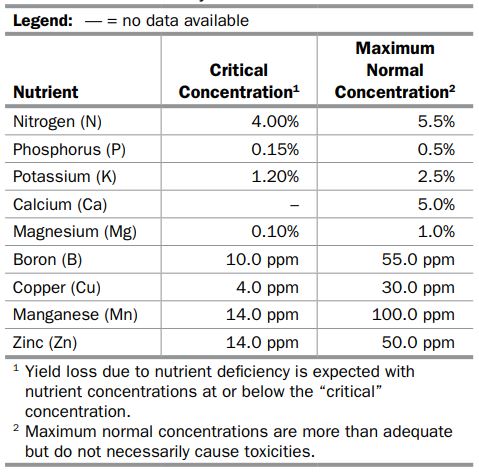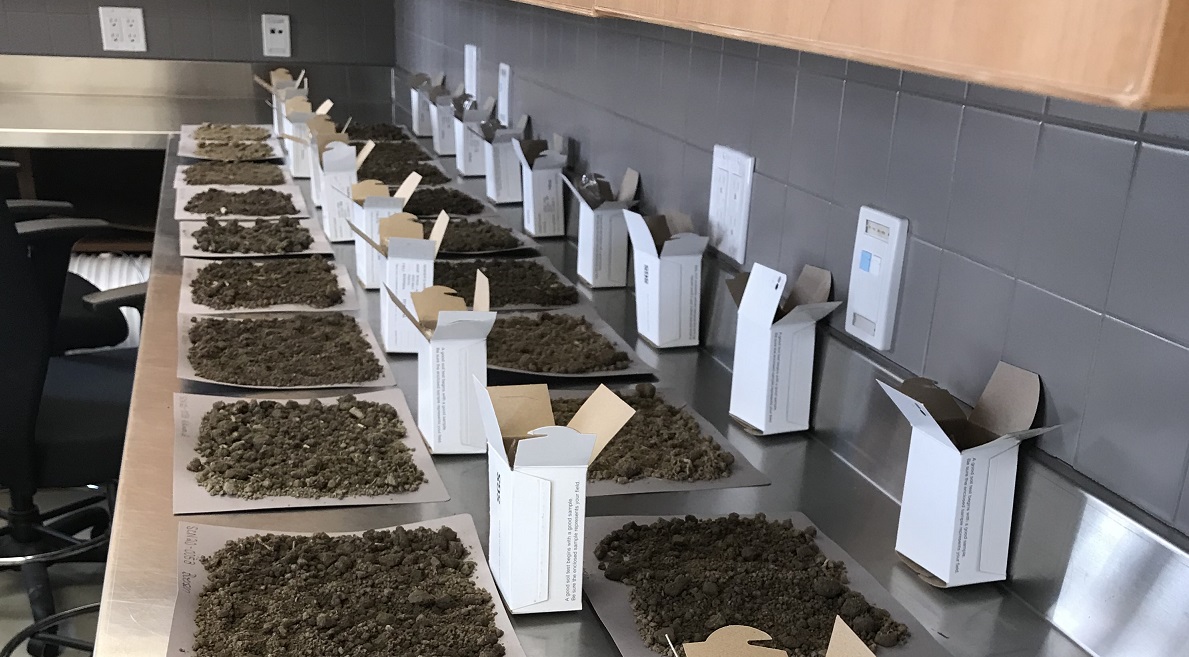The OMAFRA-accredited soil-testing program provides assurance of appropriate analyses to support guidelines for nitrogen, phosphate, potash, magnesium, zinc and manganese fertilizer, along with parameters for the amount and type of lime to apply. The analytical methods used were chosen to provide accurate results on the range of soils found in Ontario.
There is no formal accreditation process in Ontario for plant tissue analysis. However, accredited labs that perform plant analysis are monitored and provide quality analysis and interpretation of plant tissue samples.
With manganese, plant analysis, visual symptoms and the soil test are all useful. OMAFRA accredited tests are not available for boron, copper, iron or molybdenum. Current tests for these nutrients have not provided good estimates of the availability of these nutrients to plants. Plant analysis is generally a better indicator of deficiencies of these nutrients.
Soil Sampling
Micronutrient deficiencies frequently occur in small patches in fields. In these cases, soil or plant analysis taken from the entire field is unlikely to identify the problem. Collect separate samples of problem and adjacent good areas, to allow for diagnostic comparison.
More information on soil sampling can be found in OMAFRA Publication 811, Agronomy Guide for Field Crops.
Plant Analysis (Tissue Sampling)
For dry edible beans, sampling the top fully developed leaf (three leaflets plus stem) at first flowering is preferred for plant nutrient analyses. Refer to Table 1 below for interpretation of plant analysis for dry edible beans. Sample plants suspected of nutrient deficiency as soon as the problem appears. If sampling occurs at times outside of the recommended timing, collect samples from both healthy and injured areas so comparisons can be made. Take a soil sample from the same area and at the same time as the plant sample. Values in Table 1 apply to the top fully developed leaf (three leaflets plus stem) at first flowering.
Take samples for plant analysis from at least 20 plants distributed throughout the area chosen for sampling. Each sample should consist of at least 100 g (3.5 oz) of fresh material. Avoid contaminating plant tissue samples with soil. Even a small amount of soil will cause the results to be invalid, especially for micronutrients. Soil samples from “deficient” and “good” areas should also be collected at the same time for diagnostic purposes.
Deliver samples of fresh plant material directly to the laboratory. If samples are not delivered immediately, dry them to prevent spoilage. Samples may be dried in an oven at 65°C or less, or dried in the sun provided precautions are taken to prevent contamination from dust or soil. Avoid contact of samples with galvanized (zinc-coated) metal, brass or copper.
Table 1. Interpretation of plant analysis for dry edible beans

Plant analysis measures the nutrient content of plant tissue. Comparing the results against the “normal” and “critical” values for the crop can indicate whether nutrient supply is adequate for optimum growth. Plant analysis is independent of soil testing and can provide a valuable “second opinion,” especially for phosphorus, potassium, magnesium and manganese. It is less reliable for nitrogen and zinc. For boron and copper there is no reliable soil test, so plant analysis and visual symptoms are the methods used for diagnosing deficiencies.
Plant analysis has limitations. Interpreting the results is often difficult since plant-tissue analysis does not usually indicate the cause of a deficiency or the amount of fertilizer required to correct it. Plant analysis is most useful if combined with visual inspection of the crop and soil conditions, knowledge of past management in the field and a current soil test to provide information about soil nutrient levels and soil pH.
Results are difficult to interpret if samples are taken at times other than those recommended. Nevertheless, sample plants suspected of being nutrient deficient as soon as a problem appears. Samples are best taken from a problem area rather than from the entire field, and it is often helpful to sample an adjacent area of healthy plants at the same time, for comparison.
